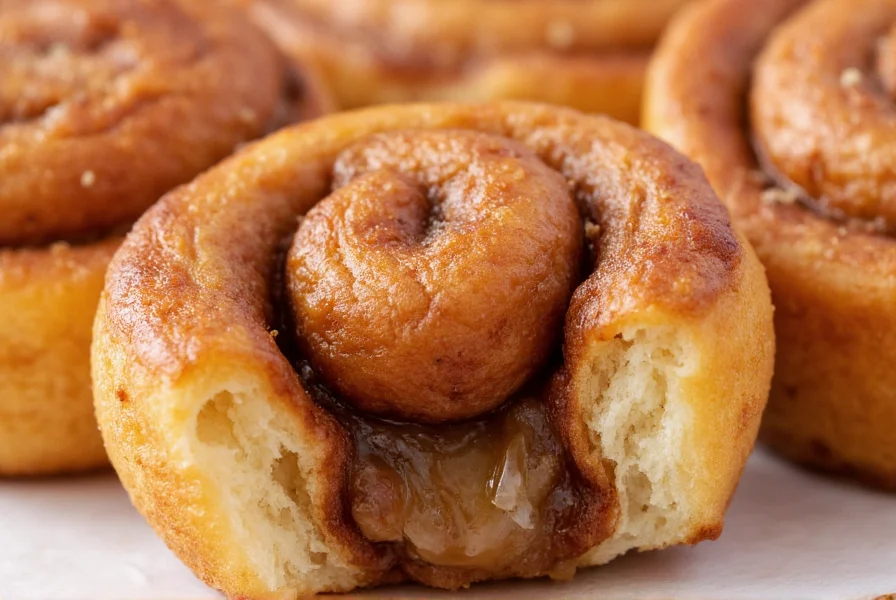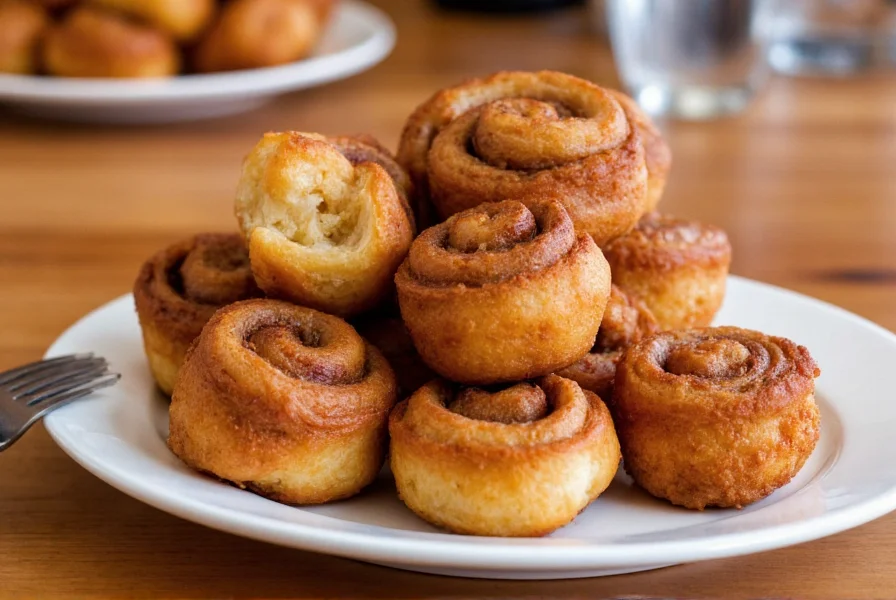Fried cinnamon rolls represent a beloved culinary tradition with deep roots in Southern American cooking. Unlike their baked counterparts that spend 20-30 minutes in the oven, these treats transform from raw dough to golden perfection in mere minutes through deep frying. This method creates an extraordinary textural experience—crisp and flaky on the outside with an irresistibly soft, pull-apart interior filled with melted cinnamon and sugar.
The Origins of Fried Cinnamon Rolls
While cinnamon rolls trace their ancestry to Swedish kanelbullar, the fried variation emerged from American soul food traditions. Southern cooks adapted the concept using techniques familiar from beignets and doughnuts, creating what some call "cinnamon doughnuts" or "cinnamon spirals." Food historians note that frying sweet doughs was particularly practical in eras when reliable ovens weren't available in every home.
Fried vs. Baked: Key Differences
| Characteristic | Fried Cinnamon Rolls | Baked Cinnamon Rolls |
|---|---|---|
| Cooking Time | 2-3 minutes per batch | 20-30 minutes plus rising time |
| Texture | Crispy exterior, soft interior | Uniformly soft throughout |
| Preparation Complexity | Moderate (oil temperature control) | Simple (oven monitoring) |
| Best Served | Immediately after frying | Within 2-3 hours of baking |
The Science Behind Perfect Fried Cinnamon Rolls
The magic happens through precise oil temperature control. At the ideal 350-375°F (175-190°C), the dough's exterior instantly sets while the interior continues cooking through steam. This creates the signature contrast between the delicate crispness outside and pillowy interior. Too cool, and the rolls absorb excess oil; too hot, and they burn before cooking through.
Professional chefs emphasize that the dough hydration level proves critical. Slightly drier dough (around 55-60% hydration) holds its shape better during frying compared to higher hydration doughs designed for baking. The fat content in the dough also affects how it interacts with the frying oil—butter-based doughs create richer flavor but require more careful temperature management than oil-based versions.
Classic Fried Cinnamon Roll Recipe
Creating authentic fried cinnamon rolls requires attention to detail but yields extraordinary results. This tested recipe serves 8-10 and takes approximately 2 hours from start to finish, including dough rising time.

Ingredients
- 2¼ tsp active dry yeast
- ½ cup warm milk (110°F)
- ¼ cup granulated sugar
- 1 large egg, room temperature
- ⅓ cup unsalted butter, melted
- 3½ cups all-purpose flour
- 1 tsp salt
- ½ cup packed brown sugar
- 2 tbsp ground cinnamon
- Vegetable oil for frying
- 1 cup powdered sugar (for icing)
- 2-3 tbsp milk (for icing)
Step-by-Step Instructions
- Prepare the dough: Dissolve yeast and 1 tsp sugar in warm milk. Let sit 5-10 minutes until foamy. In large bowl, combine yeast mixture, remaining sugar, egg, melted butter, 2 cups flour, and salt. Mix until smooth. Gradually add remaining flour until dough pulls away from sides.
- First rise: Knead dough 5-7 minutes until smooth and elastic. Place in greased bowl, cover, and let rise in warm place for 1-1.5 hours or until doubled.
- Prepare filling: Mix brown sugar and cinnamon. Roll risen dough into 16x12 inch rectangle. Sprinkle filling evenly, leaving ½ inch border. Roll tightly from long side and cut into 1-inch slices.
- Fry to perfection: Heat 2 inches of oil to 365°F in heavy pot. Fry rolls 2-3 at a time for 1.5-2 minutes per side until golden brown. Drain on paper towels.
- Finish: While still warm, toss in cinnamon sugar or drizzle with simple icing made from powdered sugar and milk.
Pro Tips for Perfect Results
Achieving restaurant-quality fried cinnamon rolls at home requires these expert techniques:
- Oil temperature control: Use a candy thermometer and adjust heat constantly. The ideal range is 350-375°F—any lower and the rolls absorb oil; any higher and they burn before cooking through.
- Dough consistency: Slightly drier dough (55-60% hydration) holds shape better during frying. If your kitchen is humid, reduce liquid by 1-2 tablespoons.
- Filling distribution: Spread filling evenly but leave a small border to prevent leakage during frying. Too much filling causes messy blowouts in hot oil.
- Frying sequence: Fry in small batches to maintain oil temperature. Overcrowding drops the temperature dramatically, resulting in greasy rolls.
- Immediate finishing: Toss warm rolls in cinnamon sugar or apply icing within 2 minutes of frying for optimal adhesion.
Regional Variations and Creative Twists
Culinary innovators have developed numerous regional interpretations of fried cinnamon rolls:
- Texas-style: Larger portions with extra-crispy exteriors, often served with pecan praline sauce
- Breakfast fusion: Stuffed with cream cheese or bacon for savory-sweet combinations
- Gourmet versions: Infused with bourbon caramel, maple bacon, or seasonal fruit compotes
- Mini portions: Bite-sized "cinnamon roll bites" perfect for parties or sampling multiple flavors
For those exploring homemade fried cinnamon rolls without yeast, baking powder-based recipes offer a quicker alternative, though they lack the complex flavor development of yeast-raised dough. The texture also differs significantly—yeast rolls have that distinctive pull-apart quality while baking powder versions resemble cake doughnuts.
Storage and Reheating Guidelines
Unlike baked cinnamon rolls that maintain quality for days, fried versions are best consumed immediately. However, if you must store them:
- Short-term (same day): Keep at room temperature in a single layer on a wire rack covered with a clean kitchen towel
- Reheating: Revive crispness by air frying at 350°F for 90 seconds or using a toaster oven for 2-3 minutes
- Avoid microwaving: This makes the exterior soggy—always use dry heat methods for reheating
- Freezing uncooked: Freeze shaped rolls on a baking sheet, then transfer to freezer bags. Fry directly from frozen, adding 30-60 seconds to cooking time
Why Fried Cinnamon Rolls Deserve a Place in Your Recipe Collection
Fried cinnamon rolls offer something special that baked versions simply can't match—the magical contrast between shatteringly crisp exterior and cloud-soft interior. This textural symphony, combined with the rich aroma of frying dough and cinnamon, creates an experience that elevates a familiar treat into something extraordinary. Whether you're hosting brunch, satisfying a sweet craving, or exploring Southern culinary traditions, mastering how to make fried cinnamon rolls at home adds a versatile skill to your cooking repertoire.
Frequently Asked Questions
Can you make fried cinnamon rolls with canned biscuit dough?
Yes, canned biscuit dough works well for quick fried cinnamon rolls. Simply flatten each biscuit, spread with cinnamon sugar filling, roll up, and cut into spirals. Fry at 360°F for 60-90 seconds per side. This method produces delicious results in under 30 minutes with minimal effort, making it perfect for last-minute cravings.
What oil is best for frying cinnamon rolls?
Neutral oils with high smoke points work best for frying cinnamon rolls. Canola, vegetable, or peanut oil (350-375°F) provide clean flavor and optimal frying performance. Avoid olive oil (too low smoke point) or coconut oil (distinct flavor that may overpower the cinnamon). For authentic Southern flavor, some chefs use a blend of vegetable oil and a small amount of bacon grease.
Why do my fried cinnamon rolls fall apart during cooking?
Fried cinnamon rolls typically fall apart when the filling contains too much moisture or when the dough isn't sealed properly. To prevent this, use a drier filling (mix cinnamon with sugar only—avoid butter or wet ingredients in the filling itself), leave a small border when spreading, and pinch the dough seam firmly. Chilling the shaped rolls for 15 minutes before frying also helps them hold their shape.
How do you keep fried cinnamon rolls from getting soggy?
To prevent sogginess, ensure your oil maintains a steady 360-370°F throughout frying. Drain rolls on a wire rack (not paper towels) to allow air circulation. Apply icing or cinnamon sugar while still hot—this creates a protective barrier. For longer storage, keep unfilled fried dough spirals and add fillings/toppings just before serving. Never cover warm fried rolls, as trapped steam creates moisture.
Are fried cinnamon rolls healthier than baked versions?
Nutritionally, baked cinnamon rolls generally contain less fat since they don't absorb cooking oil. However, fried versions cook much faster (2-3 minutes vs. 20-30 minutes), which may preserve more nutrients in the dough. The calorie difference per roll ranges from 50-100 calories depending on oil absorption. For a lighter option, use an air fryer with minimal oil spray, though this won't achieve the same texture as deep frying.












 浙公网安备
33010002000092号
浙公网安备
33010002000092号 浙B2-20120091-4
浙B2-20120091-4